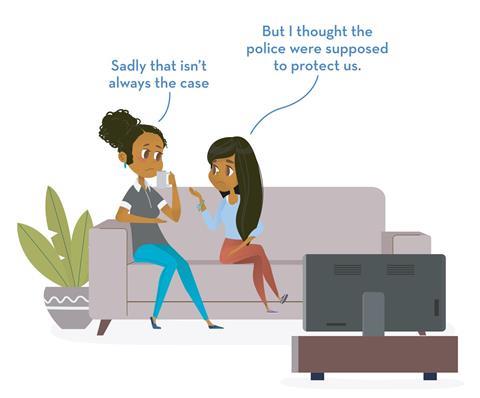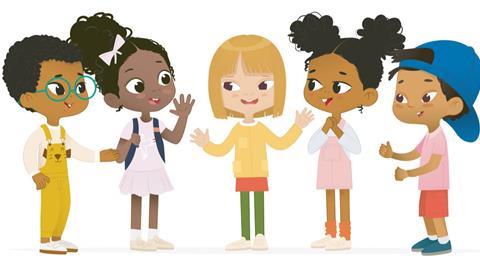It’s not good enough to be merely ‘not racist’, Christians must teach their children and grandchildren to be ‘anti-racist’, says Loretta Andrews. She unpacks the distinction and provides practical tips for acting justly when it comes to raising the next generation
My first experience of overt racism is indelibly marked on my memory. I was around eight years old; it was the summer holidays and my mum had dropped my twin sister and I at the local swimming pool.
After we’d finished swimming, we sat outside on the bus stop bench to wait for Mum, who was picking us up: two little brown girls on their own. Suddenly, a car carrying two men came tearing along the road. As it passed us, it slowed and I could see that the window was rolled down; one of the men shouted something. It was frightening, but we couldn’t make out what he’d said over the car’s engine.
To our shock, we watched as the car got to the end of the road, turned around and came back towards us. We huddled a little closer together as they drew alongside us. Now their words were loud and clear. They spat them out, with twisted, angry faces: “Go back to where you came from, Pakis!” Then they screeched away.
We sat there terrified; shocked that two grown men had shouted at us, amazed that they took the time to turn their car around to make sure we heard their insult, and confused at being called ‘Pakis’.
My sister and I are mixed race: our dad is black, from St Lucia in the Caribbean, and our mum is white, from London. Why did these men think we were from Pakistan and why would that be an insult, anyway? Luckily, our mum turned up moments later, but I’ll never forget the feelings I had that evening as my mind kept replaying the event. It was a mixture of confusion, fear and growing outrage.
I’ve experienced many incidents of racism since that day, but this was the first time I realised that I would be treated differently because of my skin colour.
Generational justice
Growing up being brown, like every other black or brown person you talk to, I simply learned to toughen up, be resilient, work hard and get on with life, despite the odds stacked against me. For people of colour, sometimes an obvious incident provides a stark reminder of our disadvantage.
Or, more commonly here in the UK, subtle microaggressions or lack of representation chip away at our confidence and undermine our abilities. I remember one such incident at primary school, when I had wanted to be the fairy princess in the school play.
I don’t remember the words the teacher used, but she and the other children made it clear that I couldn’t possibly be the fairy princess – and it was obvious why. Instead, a blonde-haired, blue-eyed girl got the role. I must have been only five or six, but I remember understanding that this was something to do with the way I looked; that I wasn’t beautiful or special enough to be a fairy princess.
EDUCATION ABOUT RACISM HAS TO START IN THE HOME
Any parent will tell you that the number of thoughts, questions, scenarios, fears and anxieties that flood your mind as you approach the birth of your child is utterly overwhelming. When I became a mum, thoughts that had never before occurred to me kept me awake at night, such as: What am I going to teach my son about religion, sexuality, injustice and, importantly, race?

Who would I tell him he was and how could I help him to own that? We want to teach our children well. We want to do better than our parents did. We want them to have the freedom to make their own choices, but to make good and healthy ones.
From the moment my son was born, I have tried to include his heritage in his upbringing where I can but, honestly, I have failed in many areas. Some failures have been due to my son’s lack of exposure to the black side of his family (literally none is left in England anymore, now that my dad has passed away) and some are due to things I took for granted.
In 2020, the resurgence of the Black Lives Matter movement in the wake of George Floyd’s murder was an opportunity to open conversations about race with my son and my friends. It was like ripping a bandage off an old wound and finding that it hadn’t healed as well as I’d thought.
It exposed hurts I’d carefully tucked away from my consciousness. But it was also interesting, encouraging and sometimes heartbreaking to see my friend’s responses – particularly those of my white friends. For many of them, a light suddenly switched on in their heads; they expressed their sorrow at how oblivious they had been to my experience as a non-white person.
Many committed to doing the work of re-educating themselves now that their eyes had been opened to racism. Many also got in touch with questions and concerns. It was an emotionally exhausting time but I felt that I was seen and heard, and I was filled with more hope for real change than I’d ever been before.
One friend who reached out was Ruth Hill, with whom I eventually co-wrote Talking to Children About Race (SPCK). I was so impressed with how she approached the conversation, as well as by what she was asking, that (with her permission) I shared her message publicly on my Facebook feed. Many people saw that post and, as a result, we were asked to write the book.
Our intention was not to preach, condemn or slap down; rather, we hope the book will be a reassuring arm around the shoulder of all those who want to learn and evolve from being merely not racist to anti-racist, and who want to help their children to do better than our generation and those before us.

What’s the difference?
But why does it matter? Why do we need to be anti-racist and what does that even mean?
To be ‘not racist’, one could see a racist incident happen and exclaim how outrageous it is, feeling confident that we would never do the same.
To be anti-racist means to not just witness this behaviour and condemn it, but to step in and confront it; to stop it if we can or, at the very least, to give support to the victim by checking they are OK and helping them to address the incident if they want to.
In short, to be ‘not racist’ is passive; to be ‘anti-racist’ is active. I would hope that most Christian parents and caregivers are not racist, but whether they are anti-racist is another question entirely.
Before we can talk to children about race, we have to do the hard work of facing, learning and wrestling with some of these questions and topics ourselves. None of us likes to admit our less attractive traits but, if you’re a person who wants to do better – for yourself, your children and grandchildren, then it’s necessary to face them.
We need to know what we’re getting wrong before we can get things right; being honest about where bias – conscious or unconscious – may exist within us is a good place to start.
Think about a few scenarios and question your motives. We first have to recognise these thoughts in ourselves, acknowledge them, challenge them and dismantle them, and then we can work on changing them:
- Recognise
- Acknowledge
- Challenge
- Dismantle
- Change
When we consider talking to our children about issues of race and racism, it might be helpful to think about how they perceive their place in the world as children who are white or non-white. What have they already noticed or experienced? You may be surprised. Children pick up on the behaviours and attitudes of those around them very quickly.

They learn by observing, and they may have already learned more from how you respond to certain situations than from what they’ve heard you say. While you may not be using racist language or telling your children to treat people of colour differently, they will pick up on how you interact with and react to different people. We can underestimate children and forget to simply ask them what they think and know. Anti-racism work must start when they are young.
I DON’T THINK PEOPLE ARE NATURALLY RACIST, OR ARE BORN HATING OTHERS, BUT IMPLICIT RACIST MESSAGING STARTS AT A SCARILY YOUNG AGE
Healthy attitudes and identities
We have to remember that teachers may not know or do any better than us, so education about racism has to start in the home. We must instigate these conversations and not delay them. We must tell our children the truth about racism. We begin this process by first facing and challenging our own thoughts, feelings and behaviour. As the novelist James Baldwin said: “Not everything that is faced can be changed; but nothing can be changed until it is faced.”
When we talk to our children, we must encourage them to question us as they, too, can help to expose our own prejudices and unconscious bias. Our children are wise and knowledgeable; they are increasingly being taught to accept people as they are, regardless of race, gender or other elements of identity. They can help us to be better, just as we are helping them. Remember to:
- Inform yourself
- Open a dialogue
- Model behaviour
- Support development
Make sure that you’re not only calling out racism and negative incidents but also pointing out positive attributes of people of colour. Highlight achievements, successes and the everyday joyful lives of people of colour.
Buy books with black heroes or heroines (not just non-white sidekicks) and those that educate kids about black history and champion black historical figures. Make sure that their toys represent a diversity of people. Try to eliminate the notion of ‘other’ as much as possible and incorporate diversity into your everyday life.

Colour blindness
Some people think it’s racist to point out colour and would prefer to pretend they are blind to our differences. The only time I think that colour blindness is ever at play is with very young children. I don’t think that very young children attach any meaning to skin colour and, even if they express curiosity about difference, it is simply that – an inquisitiveness that provides an opportunity to learn.
Racism is learned from the attitudes of others and societal messaging, both implicit and explicit. But it’s important to point out that children’s indifference to skin colour doesn’t mean that they don’t ‘see’ it; they just haven’t learned to attach any negative connotations to it…yet.
It’s all right for children to ask questions and they should never be shamed for doing so. Instead, their questions should be viewed as teaching opportunities. Admittedly, kids often choose the most awkward moment to ask a question, but try not to be embarrassed, and answer with confidence.
I don’t think people are naturally racist, or are born hating others, but implicit racist messaging – such as what is and isn’t attractive, beautiful, desirable, popular or preferable – starts at a scarily young age. And it is because of this that we must start talking to our children about race and racism while they are young, too





















![Jesus-myths-01-[Recovered]](https://d17xjl6rg4e8ic.cloudfront.net/Pictures/100x67/6/3/7/45637_jesusmyths01recovered_933246.jpg)














